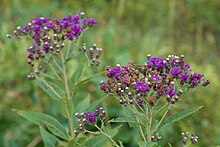| Vernonia baldwinii | |
|---|---|

| |
| Vernonia baldwinii inflorescence | |
| Conservation status | |
 Secure (NatureServe) | |
| Scientific classification | |
| Kingdom: | Plantae |
| Clade: | Tracheophytes |
| Clade: | Angiosperms |
| Clade: | Eudicots |
| Clade: | Asterids |
| Order: | Asterales |
| Family: | Asteraceae |
| Genus: | Vernonia |
| Species: | V. baldwinii |
| Binomial name | |
| Vernonia baldwinii Torr. | |
Vernonia baldwinii, commonly known as western ironweed or Baldwin's ironweed, is a perennial herb native to the central United States. It is in the Asteraceae (aster) family.
Description
Vernonia baldwinii is a tall, perennial herb with rhizomes. Its stems are densely tomentose, branched, round in cross section, and range up to 1.2 m (3 ft 11 in) in height, sometimes taller. Its leaves are lanceolate, cauline and alternate, and are about 15 cm (5.9 in) in length and 4.5 cm (1.8 in) in width. The larger leaves have serrated edges. The upper surface of the leaves is minutely hairy, and the lower surface has longer, often bent or tangled hairs.
The inflorescence is showy and somewhat flat-topped, consisting of irregularly branched terminal panicles, and measures 30 cm (1 ft) or more across. Flowerheads have 17 to 34 disk flowers only, with no ray flowers. The corollas on the disk flowers are deep pink to purple, 5-lobed, glabrous, and 0.3–0.4 in (8–10 mm) long.
Taxonomy
The genus Vernonia is named for the English botanist William Vernon, and the species baldwinii is named for William Baldwin, the American botanist and physician who collected the plant.
The common name "western ironweed" is derived from the range of the plant, the western United States, and derived from the toughness of the stem and roots of the plant.
Distribution and habitat
It grows in dry soil in prairies, pastures, open grounds, and woods, ranging from Iowa to Missouri, Nebraska, Kansas, and Texas.
Ecology
The flowers bloom in the summer, from May to September, attracting bees, butterflies, and other insects. American goldfinches and other birds eat the seeds.
References
- ^ "Vernonia baldwinii page". www.missouriplants.com.
- "NatureServe Explorer 2.0". explorer.natureserve.org.
- NRCS. "Vernonia baldwinii". PLANTS Database. United States Department of Agriculture (USDA). Retrieved 9 September 2018.
- Robert H. Mohlenbrock (2017). Flowering Plants: Asteraceae. The Illustrated Flora of Illinois. Vol. 3. SIU Press. p. 89. ISBN 9780809336067.
- ^ "Know Your Natives – Baldwin's Ironweed". Arkansas Native Plant Society. 12 August 2019.
- ^ Amanda Neill, ed. (2005). A Dictionary of Common Wildflowers of Texas & the Southern Great Plains (illustrated ed.). TCU Press. p. 160. ISBN 9780875653099.
- Nathaniel Lord Britton, Addison Brown (1913). An Illustrated Flora of the Northern United States: Canada and the British Possessions from Newfoundland to the Parallel of the Southern Boundary of Virginia, and from the Atlantic Ocean Westward to the 102d Meridian. Vol. 3 (2 ed.). C. Scribner's Sons. p. 353.
- "Western Ironweed (Baldwin's Ironweed)". Missouri Department of Conservation.
External links
 Media related to Vernonia baldwinii at Wikimedia Commons
Media related to Vernonia baldwinii at Wikimedia Commons Data related to Vernonia baldwinii at Wikispecies
Data related to Vernonia baldwinii at Wikispecies
| Taxon identifiers | |
|---|---|
| Vernonia baldwinii |
|